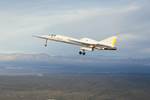Boom Supersonic makes progress in flight speed records, Overture airliner development
Sixth flight reaching Mach 0.67, equipment installation in North Carolina facility and fuselage panel fabrication testing move supersonic travel plans forward.
XB-1’s sixth flight, expanding altitude envelope to 20,000 feet. Source (All Images) | Boom Supersonic
(Denver, Colo., U.S.) has been steadily progressing the XB-1 — the company’s composites-intensive demonstrator jet, nicknamed Baby Boom — over the course of October 2024. This includes two additional flights and setting its new speed record to break the sound barrier. Meanwhile, Boom continues to advance work for the Overture airliner, including the installation of key equipment at the Overture Superfactory, and initial production of test fuselage panels in partnership with (Rome, Italy).
XB-1’s fifth flight, conducted on Oct. 7 from Mojave Air & Space Port, represented a crucial benchmark in Boom’s test program. The aircraft was taken to a top speed of Mach 0.69 (~428 knots true airspeed) over the course of the 50-minute flight, and an altitude of 17,800 feet. This marked the aircraft’s highest, fastest and longest flight to date, and it reached the halfway point of Boom’s planned subsonic test flights.
On Oct. 25, XB-1 completed its sixth flight, reaching 20,000 feet at Mach 0.67. Central to this achievement was the successful use of the flutter excitation system (FES), which intentionally induces vibrations to test structural resilience at high speeds, assuring engineers of XB-1’s stability as the aircraft approaches transonic flight. (.)
Leonardo builds first test panels .
While XB-1’s flight testing progresses, the groundwork for Overture is taking shape. The Overture Superfactory in North Carolina, completed in June 2024, installed a 15-ton crane, marking one of the first major pieces of equipment ready for Overture’s assembly line.
In addition, aerospace partner Leonardo has also begun fabricating test panels for the Overture fuselage. These will be cut into several small “coupons” to generate test data that Boom will use to calibrate Overture’s fuselage design.
Boom is targeting the end of the year to complete XB-1’s march toward the first independently developed supersonic plane. With ongoing progress and support from our partners, Boom believes it is is closer than ever to reintroducing supersonic travel to the skies.
Author’s note: In a , Boom Supersonic discussed its choice of materials for the XB-1 demonstrator. Accordingly, a majority of XB1’s fuselage structure, as well as some brackets, is manufactured from a combination of carbon fiber and titanium, both of which are said to compatible because they have “similar heat characteristics and expand at a closer rate.”
Related Content
-
Low-cost, efficient CFRP anisogrid lattice structures
CIRA uses patented parallel winding, dry fiber, silicone tooling and resin infusion to cut labor for lightweight, heavily loaded space applications.
-
“Structured air” TPS safeguards composite structures
Powered by an 85% air/15% pure polyimide aerogel, Blueshift’s novel material system protects structures during transient thermal events from -200°C to beyond 2400°C for rockets, battery boxes and more.
-
Development of a composite liquid hydrogen tank for commercial aircraft
Netherlands consortium advances cryogenic composites testing, tank designs and manufacturing including AFP, hybrid winding, welding of tank components and integrated SHM and H2 sensors for demonstrators in 2025.






